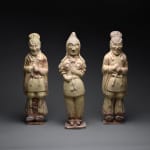Sui Set of a Military Official and Two Tomb Guardians, 581 CE - 618 CE
Glazed Terracotta
39.1 x 11.4 cm
15 3/8 x 4 1/2 in
15 3/8 x 4 1/2 in
H.030
Further images
This set of one military official and two tomb guardian warriors, zhenmuyong in Chinese, typifies Sui period style which is characterized by the use of 'straw colored' glaze over white...
This set of one military official and two tomb guardian warriors, zhenmuyong in Chinese, typifies Sui period style which is characterized by the use of "straw colored" glaze over white pottery. Though dressed in military attire typical of the period, the tomb guardian warriors differ from ordinary soldiers by their exaggerated facial expressions which suit the purpose to fend off evil from the burial site. The kuxi ensemble of long-sleeved tunic and tied and pleated pants is covered by liangdang armour; an apron-like leather shield belted at the waist and buttoned over the shoulders. Upturned shoes and a fitted cap complete the ceremonial costume, which was probably modelled on that of palace guards rather than actual combat soldiers. The grimacing faces, with wrinkeled brow and large noses, suggest foreign status. This element is also present in the military officer whose broad nose, high cheekbones and narrow inset eyes also differ from typical Han Chinese features. The military officer wears ornate helmet that forms a conical peak and covers the crown, forehead, and ears with mail draping over the shoulders. The officer's outer chest armour is decorated with images of mythical beasts and tigers in relief on the shoulders, collar and chest plates. Also wearing a two piece ensemble tied at the waist, the officer sports buffon-like pantalons tied at the ankles over boots to facilitate battle readiness. These superb Sui pieces enhance any collection of Chinese art.





